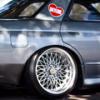Announcements
-
Similar Content
-
Latest Posts
-
roof rail delete used to be a thing, they were made locally for a while too
-
By AnimalGarage · Posted
I can get more photos of it here soon and I plan to make a thread detailing the process. I received the car this way and it sorely needs refinishing. That is probably the most appealing photo of it. Up close it is fading, cracked, and needs to be re-glued. Depending on their condition I'm on the fence between refinishing or making a new set. Another angle hiding the pimples and razor pumps -
By AnimalGarage · Posted
According to this thread the RS4V with build plate RC40 comes with the R200 diff @ 4.083 ratio as well (mine has said RC40 denotation). We may need to check if the axle stubs are the same pattern as well. The auto subframes have longer axles. However I think yours being a later Series 2 as well, we should have the same bolt pattern for the diff stubs. Unless your upgraded rear also has upgraded axles. Either way, I would not be opposed to pulling the covers to check so I can inspect that fancy rear core Also I don't have HICAS. I don't believe that should change things but I hope the people here with heaps more experience than me can correct me if I'm wrong Let me know if you want to attempt to make this work and I can get some pictures of mine from under the car. -
By joshuaho96 · Posted
It's not that straightforward. For example I have had this code because my ignitor/power transistor wires were unplugged. It knows something is wrong but has no idea what it means. If you want to actually diagnose this I recommend following the service manual flowchart for code 21. Ohm out the harness, coilpacks, inspect the ECU, etc. And again, it's entirely possible for there to be no problem at all but if you're running a different coilpack it'll trigger the code because it doesn't like what it sees. -
If it (the code) wasn't still current, it should have gone away by itself by now. No, nothing it 10/10. But it is quite likely. Everything else to do with the ignition could still be responsible (which is wires and connectors). The car is an old piece of shit now, so all the wires and connectors are also old pieces of shit.
-




Recommended Posts
Create an account or sign in to comment
You need to be a member in order to leave a comment
Create an account
Sign up for a new account in our community. It's easy!
Register a new accountSign in
Already have an account? Sign in here.
Sign In Now